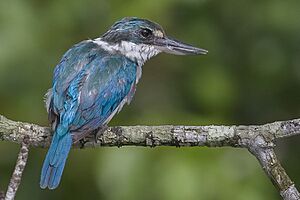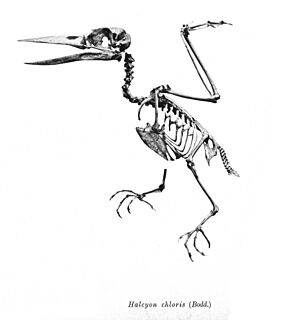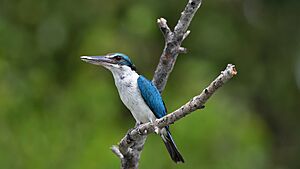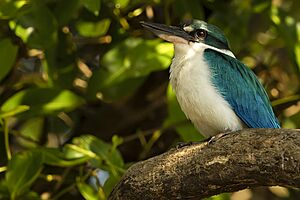Collared kingfisher facts for kids
The collared kingfisher (Todiramphus chloris) is a cool, medium-sized bird from the kingfisher family. It's also known by other names like the white-collared kingfisher or mangrove kingfisher. You can find these birds in many places, from the Red Sea all the way across Asia to islands in Polynesia. There are many different types, or subspecies, of collared kingfishers, like the Pacific kingfisher and the Torresian kingfisher.
Quick facts for kids Collared kingfisher |
|
|---|---|
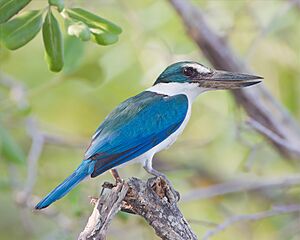 |
|
| Todiramphus chloris humii Laem Phak Bia, Phetchaburi, Thailand |
|
| Conservation status | |
| Scientific classification | |
| Genus: |
Todiramphus
|
| Species: |
chloris
|
| Synonyms | |
|
|
Contents
What's in a Name?
Scientists give every animal a special two-part name. This helps everyone around the world know exactly which animal they are talking about. The collared kingfisher's scientific name is Todiramphus chloris.
Different Types of Collared Kingfishers
There are many different types, or subspecies, of collared kingfishers. They live in different places, mostly along coasts and on islands. Here are some of the areas where you can find them:
Red Sea and Arabian Coasts
- T. c. abyssinicus – found along the southern Red Sea coasts in Somalia and Arabia.
- T. c. kalbaensis – lives on the coasts of the northeastern United Arab Emirates and northern Oman.
India and Indian Ocean
- T. c. vidali – found in western India.
- T. c. davisoni – lives in the Andaman Islands and Coco Islands.
- T. c. occipitalis – found in the Nicobar Islands.
Southeast Asia
- T. c. humii – lives on the coasts from West Bengal to Myanmar, the Malay Peninsula, Tioman, and northeastern Sumatra.
- T. c. armstrongi – found inland in Myanmar, Thailand, Indochina, and eastern China.
- T. c. laubmannianus – lives in Sumatra (except the northeast) and Borneo, including nearby islands.
- T. c. chloropterus – found on islands off western Sumatra.
- T. c. azelus – lives on Enggano Island (off southwestern Sumatra).
- T. c. palmeri – found in Java, Bali, Bawean, and Kangean Islands.
- T. c. collaris – lives in the Philippines, including Palawan and nearby islands.
Wallacea and New Guinea
- T. c. chloris – found from the Talaud Islands and Sangihe Islands through Sulawesi to the Lesser Sundas, West Papuan Islands, and northwestern New Guinea.
Micronesia
- T. c. teraokai – lives in Palau.
What Does It Look Like?
The collared kingfisher is about 23 to 25 centimeters (9 to 10 inches) long. Males usually weigh between 51 and 90 grams (1.8 to 3.2 ounces). Females are a bit heavier, weighing 54 to 100 grams (1.9 to 3.5 ounces).
Their feathers can be blue or green on top. Their belly and chest can be white or a light yellow-brown color. They have a white collar around their neck, which is how they got their name! Some kingfishers have a white stripe above their eye. Others have a white spot between their eye and beak. Some even have a black stripe through their eye.
Their large bill is black. The bottom part of the beak is usually pale yellow. Female kingfishers often look greener than the males. Young birds are not as brightly colored as adults. They might have dark, scaly marks on their neck and chest.
These birds make many different sounds. Their most common call is a loud, harsh, and metallic "kee-kee-kee" sound. They repeat this sound several times.
Where Do They Live?
Collared kingfishers are often found near the coast. They especially love living in mangrove swamps. But you can also spot them in farmland, open woodland, grassland, and even gardens. On some islands, they live further inland. They can be found in forests or mountain areas there. These birds often sit out in the open on wires, rocks, or bare tree branches.
The collared kingfisher subspecies found furthest west is T. c. abyssinica. It lives in parts of Eritrea, Sudan, and Somalia. In Arabia, there's an endangered type called T. c. kalbaensis. Only about 55 pairs or fewer of these birds exist. They mostly live in Khor Kalba in the United Arab Emirates. Some have also been seen breeding in Khor Shinas in Oman. Other types live along the coasts of India and Bangladesh. They are also found on the Andaman and Nicobar Islands. In Southeast Asia and Indonesia, these kingfishers are common. They can be found far inland in some areas.
What Do They Eat?
In coastal areas, collared kingfishers love to eat small crabs and shrimps. But they eat many other animals too! This includes insects like beetles, cicadas, and grasshoppers. They also eat spiders, earthworms, snails, frogs, lizards, and small snakes. Sometimes they even catch small fish, and very rarely, tiny birds or mice.
The collared kingfisher waits very still for a long time. It watches for its prey from a perch. When it sees something, it glides down to catch it. Then it flies back to its perch. If the prey is large, the kingfisher will hit it against the branch. This helps to make sure the prey is subdued. Any parts of the food that the bird can't digest are coughed up as pellets.
Family Life
The collared kingfisher makes its nest in a hole. This can be a natural hole in a tree. Or, the birds might dig a burrow themselves. They dig in rotten trees, termite nests, or earth banks. They also sometimes use old woodpecker holes.
They usually lay two to five round, whitish eggs. The eggs are laid right on the floor of the burrow. No extra nest material is used. Both the mother and father bird help to keep the eggs warm. They also both feed the baby birds. The young birds leave the nest about 44 days after they hatch. Often, these kingfishers will raise two groups of babies in one year.
Are They Safe?
The collared kingfisher lives in a very large area. There are also many of them. Because of this, scientists say they are of "least concern" for their safety. This means they are not currently in danger of disappearing.



